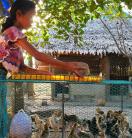A chicken gene quest to lift smallholder farmers out of poverty

A new ACIAR-funded research project will look to chicken genetics to improve the income and nutrition of smallholder farmers in Cambodia, Myanmar, and Vietnam.
Chickens are common across rural household settings in Asia. Requiring minimal land, maintenance, and capital, they are a popular choice for many smallholder farming communities.
However, the minimal input approach to chicken husbandry often results in poor production and low output, depriving many impoverished rural communities of a sustainable livelihood.
ACIAR Livestock Research Program Manager, Dr Anna Okello, said that by increasing poultry productivity through high-performing chicken genotypes, the new project could help pave a pathway out of poverty for many rural communities.
‘This new research will empower smallholder farmers by providing access to tropically adapted and more productive village poultry breeds,’ said Dr Okello. ‘By increasing production, smallholder communities can boost income, employment opportunities and improve nutrition.’
Led by the International Livestock Research Institute (ILRI), the project is building on the success of the US$14 million African Chicken Genetic Gains (ACGG) initiative, funded by Bill and Melinda Gates foundation and led by ILRI since 2014.
‘The project will also inherit ACGG’s unique experience of testing indigenous and foreign, tropically adapted genes in target countries and will contribute to the ongoing global efforts of improving village poultry systems in Africa and Asia,’ said Dr Okello.
In a low input, low output system, chickens feed only on what they can pick from the yards, ranging from kitchen leftover, waste, and some little grains. Generally, they are not well-cared for and are often exposed to extreme heat, pests, predators, and diseases.
As a result, most native chickens in Cambodia, Myanmar, and Vietnam can produce only 60 eggs/hen/year and take more than a year to achieve a live weight of 1.5kg for selling. In contrast, broiler chickens from a commercial production system are sold at six weeks at a weight of 2kg, and hens lay 250 to 270 eggs per year.
‘We will make available chicken genes that are well adapted to the current production system and produce more eggs, more live weight, and less mortality,’ said Dr. Tadelle Dessie, the project leader and ILRI principal scientist.
‘Also, high producing genes are a ‘pull’ factor that will increase productivity and positively influence other value chain nodes such as health and feeding services,’ he added.
To ensure germplasm selection success, farmers, especially women who are the primary poultry caretakers, will participate in rigorous laboratory and on-farm testing to inform genetic technology innovation with their breed preferences.
Besides, private sector actors of large and small scales, including breeding and feed companies, will also scale up project outputs.
With a highly participatory approach, the project will create innovation platforms at national and local community levels to mobilise new knowledge gained and contributed by researchers, farmers, and companies. These platforms will serve for learning and co-developing solutions across the value chains in the region.



